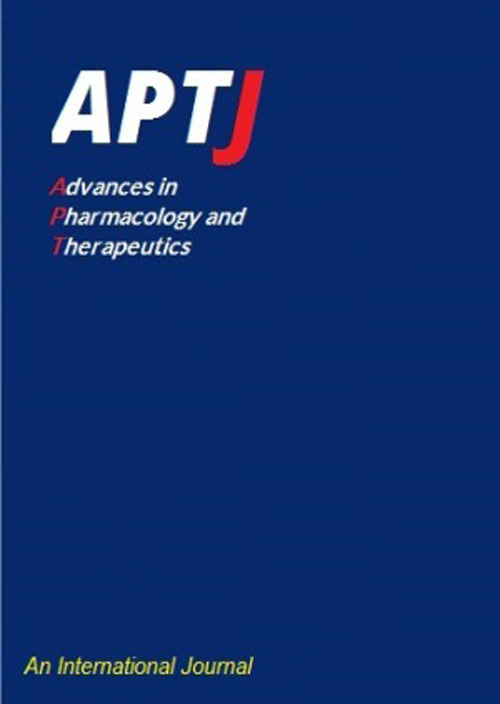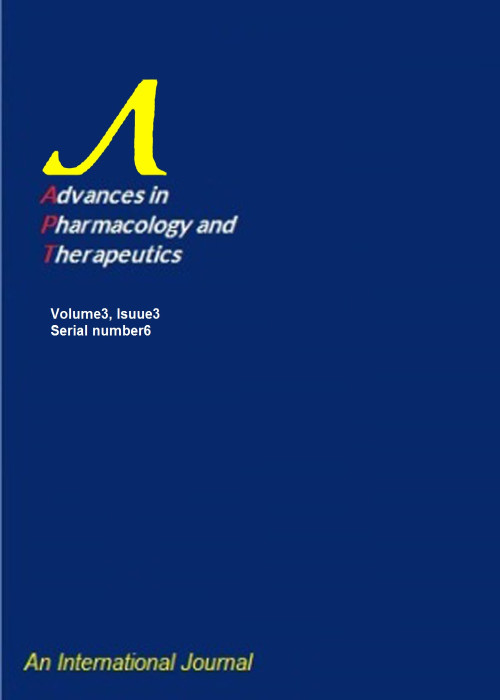فهرست مطالب

Advances in Pharmacology and Therapeutics Journal
Volume:1 Issue: 1, Summer 2021
- تاریخ انتشار: 1400/07/18
- تعداد عناوین: 8
-
Pages 1-11Aims
Solanum nigrum (S. nigrum) is a species of flowering plant from the Solanaceae family and one of the indigenous plants of Eurasia. Given the biological activities of this plant, like antimicrobial, antioxidant, and anti-inflammatory ones, this study assessed its effects on the healing process of second-degree burn wounds in rats. We also evaluated its antibacterial activity against common pathogens of burn wound infection (i.e., Pseudomonas aeruginosa, Staphylococcus aureus, and Acinetobacter baumanni).
MethodsS. nigrum fruit extract was prepared by percolation and reflux methods. The extract was applied for the treatment of animal models with second-degree burn wounds. Parameters of wound healing and maturation, including collagen deposition, epithelialization, reduction of neutrophil migration, and angiogenesis, were evaluated. The antimicrobial activity of S. nigrum fruit extract against common pathogens of burn wound infection was assessed by the agar well diffusion method via measurement of zones of microbial growth inhibition.
ResultsHistological analysis showed a significant reduction in neutrophil migration by the 20% hydroalcoholic extract vs. control group (normal saline). In addition, we found that the 20% hydroalcoholic extract was more efficient than silver sulfadiazine in augmenting collagen deposition. S. nigrum hydro alcoholic extract also showed an inhibitory effect on S. aureus.
ConclusionS. nigrum 20% hydroalcoholic extract improved some of the wound healing parameters such as collagen deposition and inflammation. It also shows an inhibitory effect on S. aureus. So, it may have therapeutic effects on burns.
Keywords: Acinetobacter baumanni, Burn, Pseudomonas aeruginosa, Solanum nigrum, Staphylococcus aureus, wound healing -
Pages 12-15
Sleep sex or sexsomnia is a relatively new disease that is considered an unusual sexual experience and behavior. Many facts about sexsomnia, including its causes, symptoms, and exact prevalence, are still unknown. Given that the symptoms of the disease occur accidentally during the night, it is tough to study this disease in the long run. This study reported a case of a 30-year-old man with sexsomnia who had no recollection of the sexual behavior he exhibited while asleep. He had lichenplanopilaris and was not receiving any psychiatric medication at the time of the study. However, he was under treatment with corticosteroids for six months, which eventually worsened his depression. This behavior attracted his wife's attention, and he was referred to a doctor due to infertility.
Keywords: Sexsomnia, Lichen planopilaris, Sleep, Corticosteroid treatment -
Pages 19-21
Certain types of behavior in people with a history of mental disorders and psychosis can engender harm. These behaviors can include rectal and vaginal use of foreign bodies by the patient. A 54-year-old married man from a low socio-economic level finished school just with grade 2 and suffering from mental retardation disorder, inserted a foreign body into the rectum and, after a week, and due to problems such as bleeding and lack of defecation, referred to the hospital and underwent an operation. During the psychiatric consultation, the patient showed to be ashamed of his unusual act. The cause of such behavior could not exactly be identified. Risperidone and Citalopram were prescribed for the patient, and behavior therapy and sex therapy were advised to prevent recurrence.
Keywords: Foreign Body, Mental Retardation, Rectum -
Pages 22-30Aims
The goal of this study was to evaluate the consumption pattern of human albumin according to the available and reliable guidelines.
MethodsThis research was a descriptive-analytical study. The study sample consisted of patients admitted to the intensive care units (ICUs) of Shahid Sadoughi and Rahnemoon Yazd Teaching Hospitals. In this study, 67 patients were selected. The study was carried out over three months. During the study, the albumin request by ICUs was investigated. Along with observing albumin orders' para-clinic findings were evaluated. The specific form of albumin consumption and prescription prepared by the Hospital Steering Board of Pharmacy was completed for each patient individually.
ResultsIn this study, 65.7% of prescribed albumin was infused for approved cases by the US food and drug administration (FDA). Administration after burn injury with 32.8% and hypoalbuminemia with 19.4% of cases were the most frequently reasonable prescribed albumin. About 34.3% of prescribed albumin (18 cases) did not have FDA-approved indications. Albumin infusion after patients edema in 14.9% of cases, nutritional support 6 % and Major surgery 6% have been the most frequently incorrect prescribed albumin.
ConclusionBased on the findings of this study, the prescription of albumin in patients admitted to ICUs of Sadoughi and Rahnemoon teaching hospitals from October to December 2015 was not completely in accordance with the guidelines. So , consulting with relevant health care professionals can be helpful to improve the proper administration of this essential and expensive drug.
Keywords: albumin, hospitals, Intensive Care Unit, Medication Therapy Management, patients -
Pages 31-40Aims
In this comparative study, we aimed to investigate the effectiveness of group reality therapy versus desipramine pharmacotherapy in reducing the craving and relapse of methamphetamine-dependent patients.
MethodsThis semi-experimental research was conducted using a control group and two experimental groups of reality therapy and desipramine pharmacotherapy. The statistical population of this study included all methamphetamine-dependent patients under methadone treatment who were referred to the health clinics of Yazd city, Iran. We selected 30 patients using convenience sampling and then categorized them randomly into three groups of reality therapy, desipramine pharmacotherapy, and control. In the pre-test stage, the risk questionnaire was administered to evaluate the stimulants. The first experimental group attended 10 reality therapy sessions once a weak and was assessed immediately after the treatment. The data were analyzed using the covariance analysis.
ResultsThe findings showed no significant difference between the total mean score of the reality therapy and desipramine pharmacotherapy groups (F= 3.289, P= 0.087). Hence, these two interventions did not affect attenuating craving to use the drugs. To check the homogeneity presumptions of the covariance matrix and variances of the two groups, the Box (6.241) and Levine (0.250) tests were applied, respectively. The results about the experimental groups (Reality therapy and Desipramine group) compared to the control group were meaningful.
ConclusionThere was no significant difference between reality therapy and desipramine pharmacotherapy groups in reducing the craving to use the drugs. The scope of changes showed that craving for drug consumption reduced in reality therapy (51.0) and desipramine pharmacotherapy (36.0) groups.
Keywords: Craving, Desipramine, Methadone, Methamphetamine, patients, Reality therapy -
Pages 41-48Aims
In Iranian culture, due to some narratives from the prophet Mohammad about the use of frankincense during pregnancy for increasing IQ in children, some women consume frankincense during expectancy. This study's goal is to evaluate the relationship between frankincense used during pregnancy and the incidence of ADHD.
MethodsIn this study, the case group comprised children 4-17 years old referring to Shahid Chamran Pharmacy in Yazd from summer to winter 2018 for receiving Methylphenidate, those with whom a psychologist had identified ADHD based on DSM-V factors. The control group included children of the same age group but without ADHD. For data gathering, a checklist was used with some questions on smoking, family history of ADHD, presence/absence of a specific disease during pregnancy, frankincense used during pregnancy, and a chemical medication consumed during pregnancy.
ResultsThe main result demonstrated that the children whose mothers used frankincense during pregnancy were 0.67 times less likely to be affected by ADHD than those whose mothers did not use this substance. However, the difference failed to be statistically significant (P>0.05).
ConclusionSome studies report that frankincense can bear a positive effect on the development of the brain and possibly adequate formation of dendrites trees, axons and induce proper communication between them, so the impact of frankincense on the brain may be justified by its protective effect against the hyperactive child.
Keywords: Attention deficit hyperactivity disorder, ADHD, Boswelia carterri, Frankincense -
Pages 49-51
The concept of catatonia was first described by a German psychiatrist, Kahlbaum, in 1874. Catatonia is a serious neurological disorder associated with a wide range of psychiatric, neurological, medical conditions, and drug-induced disorders. Nevertheless, there is no absolute guideline for treating catatonia patients in whom the cause of the disorder is unknown. Clozapine is the first atypical antipsychotic used for the treatment of catatonia. Our case was a 51-year-old single, right-handed man with schizophrenia and a specific symptom of catatonia. Despite previous studies findings revealing the efficacy of clozapine in relieving catatonia symptoms, our patient did not show a definite response to this medication. Hence, follow-up of these patients to evaluate other treatments and possible incidence or manifest of other catatonic features like waxy flexibility, echo phenomenon, and negativism are suggested.
Keywords: Catatonia, Clozapine, Neurobehavioral manifestations, Schizophrenia


